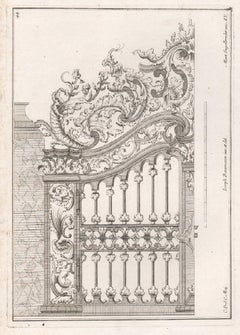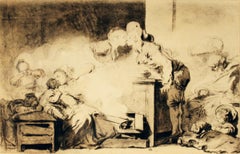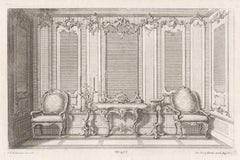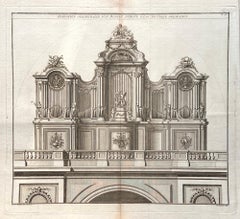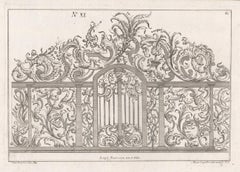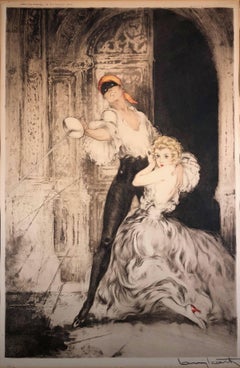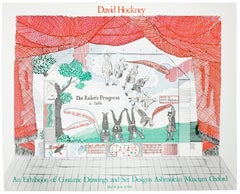Rococo Interior Prints
to
4
1
Overall Width
to
Overall Height
to
561
436
117
106
43
36
35
29
19
15
12
10
9
2
2
1
4
1
1
4
5
2
2
2
1
1
1
1
1
1
1
1
1
1
1
1
1
1
4
3
1
1
Style: Rococo
Rococo design for a gate, German mid 18th century etching
Located in Melbourne, Victoria
Rococo design for a gate, etching, by Joseph Baumann (active 1740-1760), circa 1750.
Published by Martin Engelbrecht (1684–1756).
Similar works ar...
Category
Mid-18th Century Rococo Interior Prints
Materials
Engraving, Etching
Jean-Honore Fragonard-L'Occasion Rococo Vintage
Located in Brooklyn, NY
Drawings by French Masters of the XV-XVIII Centuries. From a selection of 40 reproductions of the originals preserved in the Albertina Collection in Vienna. With an introduction and...
Category
1930s Rococo Interior Prints
Materials
Offset
Rococo interior design and furniture, German mid 18th century etching
By Franz Xaver Habermann
Located in Melbourne, Victoria
Rococo interior design and furniture, etching, by Franz Xaver Habermann (1721-1796), circa 1750.
Lettered 'F. X. Haberman, inv. et del. loh. Georg Hertel, excud : Aug. Vind., number...
Category
Mid-18th Century Rococo Interior Prints
Materials
Engraving, Etching
French pipe organ design, late 18th century engraving
Located in Melbourne, Victoria
'Elevation Geometralle d'Un Buffet D'Orgue d'Une Nouvelle Decoration'
Copper-line engraving. C1770.
380mm by 420mm (platemark) 460mm by 560mm (sheet)
From Roubo's 'L'Art du Menui...
Category
Late 18th Century Rococo Interior Prints
Materials
Engraving
Rococo design for a gate, German mid 18th century etching
Located in Melbourne, Victoria
Rococo design for a gate, etching, by Joseph Baumann (active 1740-1760), circa 1750.
Published by Martin Engelbrecht (1684–1756).
Similar works ar...
Category
Mid-18th Century Rococo Interior Prints
Materials
Engraving, Etching
Related Items
Don Juan
By Louis Icart
Located in Missouri, MO
Aquating Engraving
Image Size: approx. 20 1/4 x 13 3/8
Framed Size: 28 x 20.5 inches
Pencil Signed Lower Right
Louis Justin Laurent Icart was born in Toulouse in 1890 and died in Paris in 1950. He lived in New York City in the 1920s, where he became known for his Art-Deco color etchings of glamourous women.
He was first son of Jean and Elisabeth Icart and was officially named Louis Justin Laurent Icart. The use of his initials L.I. would be sufficient in this household. Therefore, from the moment of his birth he was dubbed 'Helli'. The Icart family lived modestly in a small brick home on rue Traversière-de-la-balance, in the culturally rich Southern French city of Toulouse, which was the home of many prominent writers and artists, the most famous being Henri de Toulouse-Lautrec.
Icart entered the l'Ecole Superieure de Commerce de Toulouse in order to continue his studies for a career in business, particularly banking (his father's profession). However, he soon discovered the play writings of Victor Hugo (1802-1885), which were to change the course of his life. Icart borrowed whatever books he could find by Hugo at the Toulouse library, devouring the tales, rich in both romantic imagery and the dilemmas of the human condition. It was through Icart's love of the theater that he developed a taste for all the arts, though the urge to paint was not as yet as strong for him as the urge to act.
It was not until his move to Paris in 1907 that Icart would concentrate on painting, drawing and the production of countless beautiful etchings, which have served (more than the other mediums) to indelibly preserve his name in twentieth century art history.
Art Deco, a term coined at the 1925 Paris Exposition des Arts Decoratifs, had taken its grip on the Paris of the 1920s. By the late 1920s Icart, working for both publications and major fashion and design studios, had become very successful, both artistically and financially. His etchings reached their height of brilliance in this era of Art Deco, and Icart had become the symbol of the epoch. Yet, although Icart has created for us a picture of Paris and New York life in the 1920s and 1930s, he worked in his own style, derived principally from the study of eighteenth-century French masters such as Jean Antoine Watteau, François Boucher and Jean Honoré Fragonard.
In Icart's drawings, one sees the Impressionists Degas...
Category
1920s Rococo Interior Prints
Materials
Engraving, Aquatint
Vintage David Hockney Exhibition Poster Ashmolean Museum 1981
Located in New York, NY
Poster produced for David Hockney’s 1981 exhibition at The Ashmolean Museum, Oxford, which displayed the sets and costumes he designed for the Glyndebourne Festival Opera’s 1975 prod...
Category
1980s Rococo Interior Prints
Materials
Offset
Original Freedom from Want 1943 vintage poster. Thanksgiving
Located in Spokane, WA
Original vintage poster: FREEDOM FROM WANT, Ours to fight for ...
Original. Artist: Normal Rockwell. Archival linen backed in fine condition, ready to frame. Note: All US Go...
Category
1940s Rococo Interior Prints
Materials
Offset
$998
H 40 in W 28.5 in D 0.05 in
THE LAMP Vintage Lithograph Poster, 1st Printing 1984, Civil Rights, Justice
Located in Union City, NJ
ROMARE BEARDEN 1970-1980
THE LAMP (after the 1984 collage on board by Bearden)
Vintage 1984 Commemorative Poster - Brown v. Board of Education 30 Years later: "The Politics of Excel...
Category
1980s Rococo Interior Prints
Materials
Offset
$315 Sale Price
21% Off
H 33.75 in W 21.5 in
The Great Sphinx & Pyramids, Giza, Egypt: A 19th C. Lithograph by David Roberts
Located in Alamo, CA
This is an original 19th century duotone lithograph entitled "The Great Sphinx, Pyramids of Gizeh" by David Roberts, from his Egypt and Nubia volumes of the large folio edition, publ...
Category
1840s Rococo Interior Prints
Materials
Lithograph
$3,980 Sale Price
20% Off
H 16.75 in W 23.75 in
Original Save Freedom of Speech, Buy War Bonds (Large) format vintage poster
Located in Spokane, WA
Original FREEDOM OF SPEECH, large size format, 1943 vintage poster. Archival linen backing with the original fold marks restored and ready to frame. This is the most popular and most requested among the Four Freedoms posters...
Category
1940s Rococo Interior Prints
Materials
Offset
$2,880
H 56 in W 40 in D 0.3 in
Interior of the Temple Abu Simbel, Egypt: A 19th C. Lithograph by David Roberts
Located in Alamo, CA
This is an original 19th century duotone lithograph entitled "Interior of the Temple of Aboo Simbel" by David Roberts, from his Egypt and Nubia volumes of the large folio edition, pu...
Category
1840s Rococo Interior Prints
Materials
Lithograph
$2,540 Sale Price
20% Off
H 16.75 in W 23.75 in
The Great Hall at Karnak, Luxor, Egypt: A 19th C. Lithograph by David Roberts
Located in Alamo, CA
This is an original 19th century duotone lithograph entitled "Great Hall at Karnac, Thebes" by David Roberts, from his Egypt and Nubia volumes of the larg...
Category
1840s Rococo Interior Prints
Materials
Lithograph
$3,500 Sale Price
20% Off
H 23.88 in W 16.75 in
Approach of the Simoon, Giza, Egypt: Original 19th C. Lithograph by D. Roberts
Located in Alamo, CA
This is an original 19th century duotone lithograph entitled "Approach of the Simoon, Desert of Gizeh" by David Roberts, from his Egypt and Nubia volumes of the large folio edition, ...
Category
1840s Rococo Interior Prints
Materials
Lithograph
$7,980 Sale Price
20% Off
H 16.75 in W 23.88 in
Colossal Statue Luxor, Egypt: Original 19th C. Lithograph by David Roberts
Located in Alamo, CA
This is an original 19th century duotone lithograph entitled "A Colossal Statue at the Entrance to the Temple of Luxor" by David Roberts, from his Egypt and Nubia volumes of the larg...
Category
1840s Rococo Interior Prints
Materials
Lithograph
$620 Sale Price
20% Off
H 23.75 in W 16.75 in
Abu Simbel Temple to Ramesses II in Egypt: A 19th C. Lithograph by David Roberts
Located in Alamo, CA
This is an original 19th century duotone lithograph entitled "The Great Temple of Aboo Simble, Nubia" by David Roberts, from his Egypt and Nubia volumes of the large folio edition, p...
Category
1840s Rococo Interior Prints
Materials
Lithograph
$3,500 Sale Price
20% Off
H 16.75 in W 23.88 in
Three of the Cloister Series Hand signed and inscribed to the artist's famed CPA
Located in New York, NY
Robert Rauschenberg
Three of the Cloister Series (Hand signed and inscribed to CPA Ruben Gorewitz, Andy Warhol's business partner), 1981
Offset lithograph poster (Signed by Robert Ra...
Category
1980s Rococo Interior Prints
Materials
Lithograph, Offset
Previously Available Items
French Commode Table Etching From "The Gentleman and Cabinet-Maker's Director"
By Thomas Chippendale
Located in Houston, TX
Engraving from a book titled, "The Gentleman and Cabinet-Maker's Director" printed in 1753. Thomas Chippendale was the designer and Mary and Matthew Darly...
Category
1750s Rococo Interior Prints
Materials
Etching
H 16.5 in W 22.5 in D 0.75 in
Rococo interior prints for sale on 1stDibs.
Find a wide variety of authentic Rococo interior prints available for sale on 1stDibs. Works in this style were very popular during the 18th Century, but contemporary artists have continued to produce works inspired by this movement. Many Pop art paintings were created by popular artists on 1stDibs, including Joseph Baumann, Thomas Chippendale, and Franz Xaver Habermann. Frequently made by artists working with Etching, and Engraving and other materials, all of these pieces for sale are unique and have attracted attention over the years. Not every interior allows for large Rococo interior prints, so small editions measuring 14.57 inches across are also available. Prices for interior prints made by famous or emerging artists can differ depending on medium, time period and other attributes. On 1stDibs, the price for these items starts at $165 and tops out at $420, while the average work sells for $165.
Recently Viewed
View AllMore Ways To Browse
Herbert Gentry
Hermes Bag Painting
Highwaymen Art
Hildegard Hamilton
Hispano Suiza
Hollywood Hills Painting
Honey Kurlander
Honore Sharrer
Horatio Mcculloch
Howard Barron
Howard Rogers
Huge Mythological Painting
Hungarian Jewish Paintings
Hunt Horse And Hounds
Hunt Slonem Cardinal
Hunt Slonem Lories
Hyam Hyams
Ian Houston
